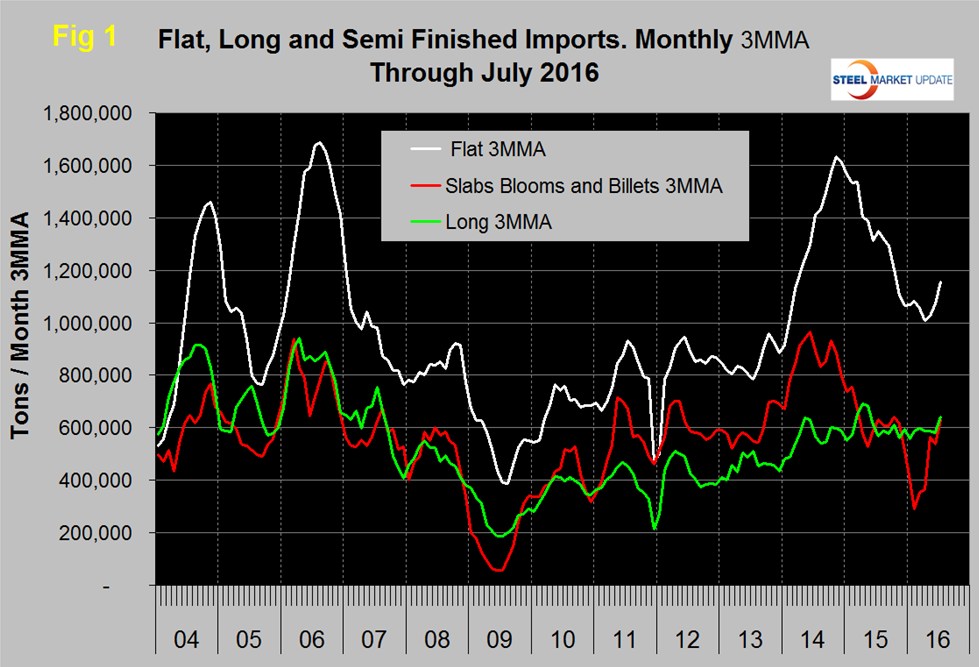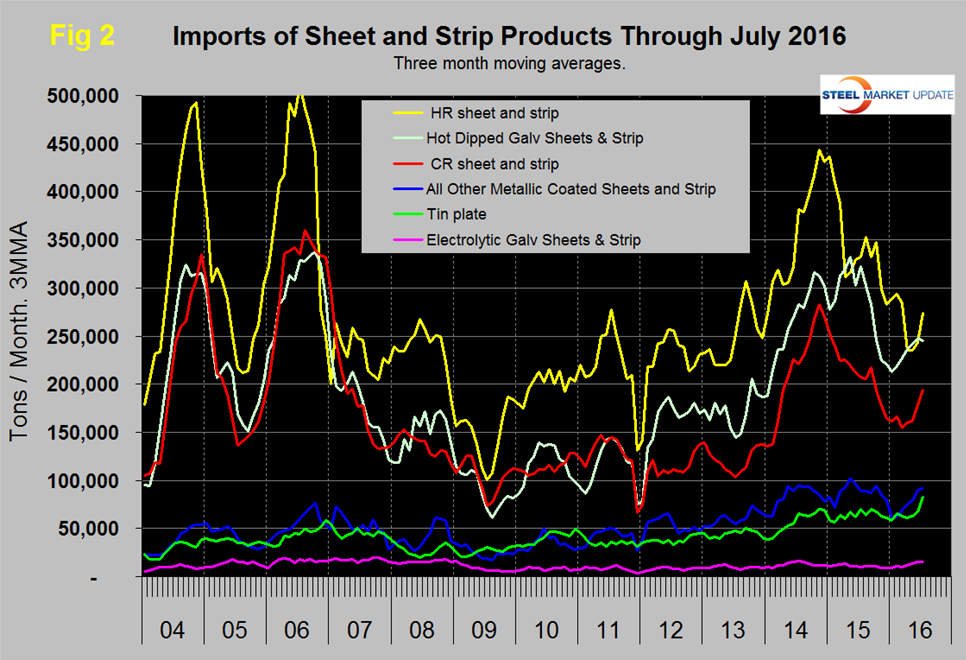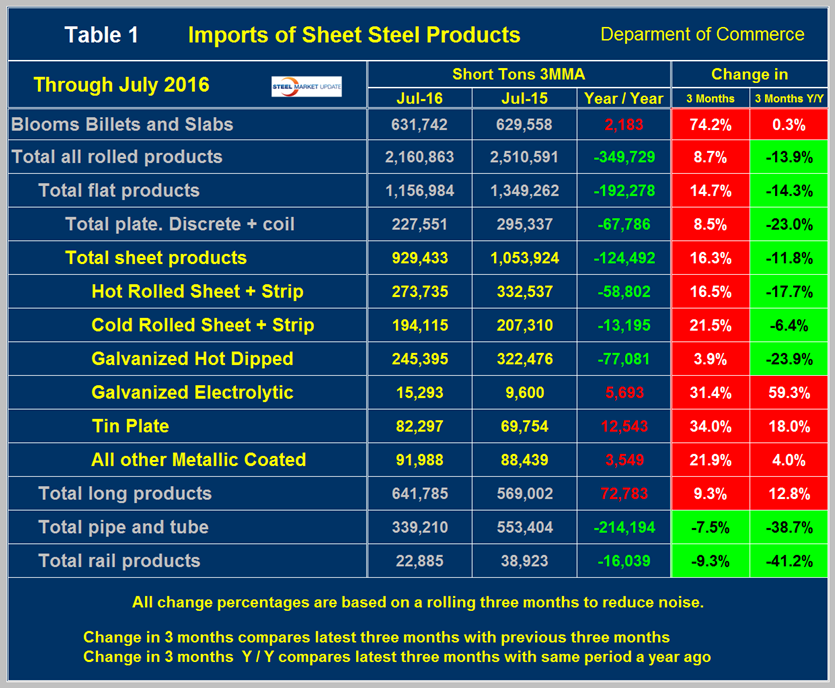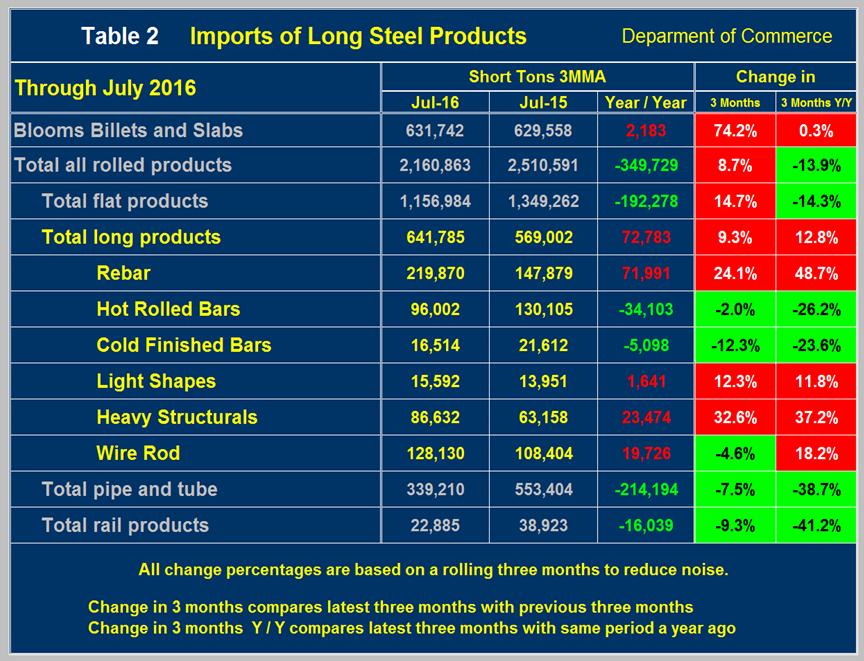Steel Products Prices North America

Flat, Long, and Semi-Finished Imports through July 2016
Written by Peter Wright
July 7, 2016
Licensed data for July was reported by the Steel Import Monitoring System of the US Commerce Department on August 2nd. An explanation of the methodology that we at SMU use to analyze the trade data is given at the end of this piece.
![]() Total rolled product licensed imports in the single month of July were 2,343,966 short tons with a three month moving average (3MMA) of 2,160,863 tons. We prefer not to dwell on single months results because even though the monthly total has been relatively steady in the last 12 months there is often extreme variability in individual products. In the comments below we use three month moving averages to get a more representative picture.
Total rolled product licensed imports in the single month of July were 2,343,966 short tons with a three month moving average (3MMA) of 2,160,863 tons. We prefer not to dwell on single months results because even though the monthly total has been relatively steady in the last 12 months there is often extreme variability in individual products. In the comments below we use three month moving averages to get a more representative picture.
Figure 1 shows the 3MMA through July licenses for semi-finished, flat and long products since January 2004.
Imports of semi-finished in July were 713,495 tons with a three month moving average of 631,742 tons. Semi-finished imports have been extremely erratic this year ranging from 168,000 in February to 777,000 in May. The July semi-finished volume was up by 20 percent from the monthly average of 2015. The 3MMA of flat rolled imports peaked at 1,634,000 tons in November 2014 and fell to 1,008,718 in April this year and increased to 1,156,984 tons in July. “Flat” includes all hot and cold rolled sheet and strip plus all coated sheet products plus both discrete and coiled plate. Long product imports have been range bound between 519,000 tons and 772,000 tons since March 2014 with no particular trend evident. In July the 3MMA of long product imports was 641,785 tons.
Figure 2 shows the trend of sheet and strip products since January 2004 on a rolling three months basis. All sheet products have reversed course and trended back up recently.
Table 1 provides an analysis of major product groups and of sheet products in detail. It compares the average monthly tonnage in the latest three months through July with both three months through April (3M/3M) and three months through July 2015 (Y/Y).
On a Y/Y basis the total of all rolled products was down by 349,729 tons or 13.9 percent, as total sheet products were down by 11.8 percent. Tubulars were down by 38.7 percent. Semi-finished slabs, blooms and billets were up by 0.3 percent and long products were up by 12.8 percent. Electro-galvanized, other metallic coated (mainly Galvalume) and tin plate were the only sheet products to have a Y/Y increase. There was an increase in all sheet products on a 3M/3M basis as indicated by the color code red. The extremely large 3M/3M increase in semis was a result of the very low February volume. The total volume of hot worked products was up by 8.7 percent 3M/3M as sheet, plate and longs all increased. The color codes in Tables 1 and 2 for the three month and year over year change show which products are improving and which have experienced import volume increases in these two time frames.
Table 2 shows the same analysis for long products.
The total tonnage of long products in July was the highest since April last year and on a 3MMA basis the volume was up by 72,783 tons y/y. Rebar accounted for almost all of that increase with the combined total of other long products being about the same. On a 3M/3M basis the total volume of long products increased by 9.3 percent led by rebar and heavy structurals that were up by 24.1 percent and 32.6 percent respectively.
Explanation: The SMU publishes several import reports ranging from this very early look using licensed data to the very detailed analysis of final volumes by product, by district of entry and by source nation which is available on the premium member section of our web site. The early look, the latest of which you are reading now has been based on three month moving averages (3MMA) using the latest licensed data, either the preliminary or final data for the previous month and final data for earlier months. We recognize that the license data is subject to revisions but believe that by combining it with earlier months in this way gives a reasonably accurate assessment of volume trends by product as early as possible. We are more interested in direction than we are in absolute volumes at this stage. The main issue with the license data is that the month in which the tonnage arrives is often not the same month in which the license was recorded. In 2014 as a whole our data showed that the reported licensed tonnage of all carbon and low alloy products was 2.3 percent less than actually receipts, close enough we believe to confidently include licensed data in this current update. The discrepancy declined continuously during the course of the twelve month evaluation as a longer time period was considered.

Peter Wright
Read more from Peter WrightLatest in Steel Products Prices North America

Nucor slows HRC price climb with $5/ton increase
After eight weeks of double-digit price increases on hot-rolled (HR) coil, Nucor slowed the price rise this week with an increase of $5 per short ton.

Domestic CRC prices surge ahead of imports
The price spread between stateside-produced CR and imports reached its widest margin in over a year.

Evraz raises plate prices $160/ton
Evraz North America (NA) has followed Nucor and SSAB with a plate price increase of its own: up $160 per short ton (st). The increase was effective immediately for all new orders of carbon, high-strength low-alloy, and normalized and quenched-and-tempered plate products, as well as for hot-rolled coil, the steelmaker said in a letter to […]

Nucor lifts HR coil to $820/ton
Nucor has increased its consumer spot price (CSP) for hot-rolled (HR) coil for a fourth consecutive week.

Nucor pushes HR spot price to $790/ton
Nucor increased its consumer spot price (CSP) for hot-rolled (HR) coil to $790 per short ton (st) on Monday, Feb. 10 – a $15/st bump vs. last week. The Charlotte, N.C.-based company has raised its weekly CSP by $40/st over the past three weeks after maintaining tags at $750/st since Nov. 12, according to SMU’s […]




